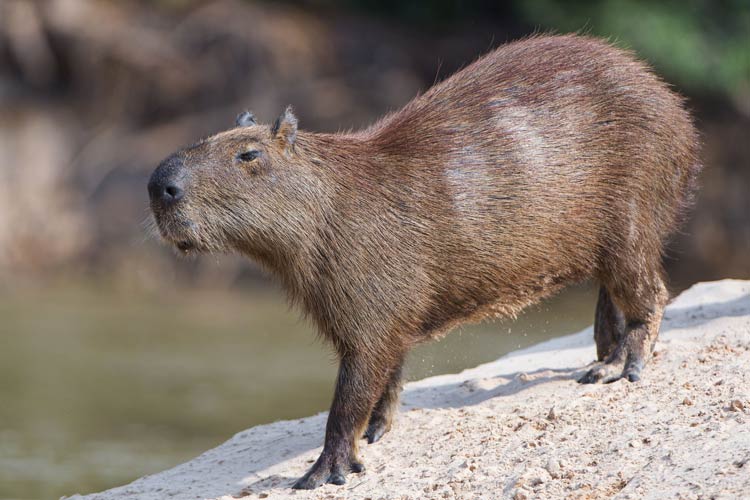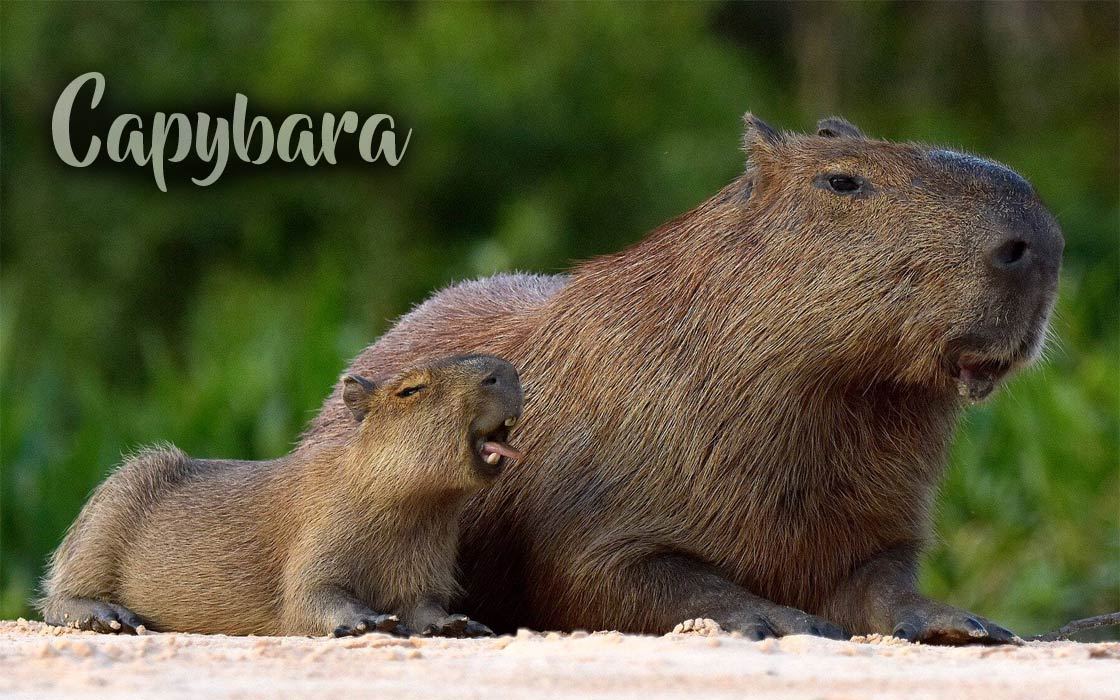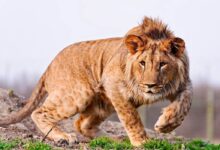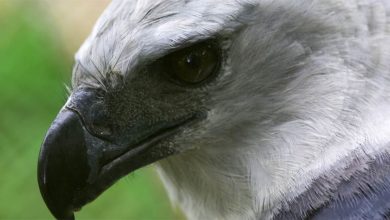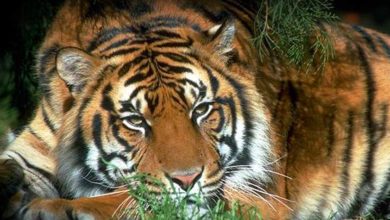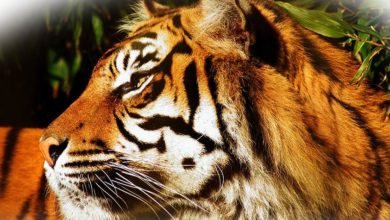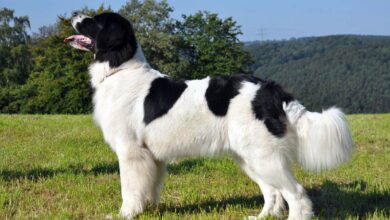The capybara, greater capybara (Hydrochoerus hydrochaeris)
If you’re looking for an adorable and unexpected animal to admire, look no further than the capybara. This giant rodent, native to South America, has captured the hearts of animal lovers around the world with its gentle nature, peculiar habits, and surprising social skills. Despite being the world’s largest rodent, the capybara is often mistaken for a furry, oversized guinea pig. But don’t let its cute appearance fool you – these creatures are fascinating and complex species with a rich history and unique ecological role. So, let’s dive into the world of the capybara and discover what makes this unusual creature so captivating.
The capybara, or greater capybara (Hydrochoerus hydrochaeris), is an intriguing and unique mammal that is both adorable and fascinating to study. With a length of 106-134 cm (41.7-52.8 inches) and standing 50-62 cm (19.7-24.4 inches) tall at the withers, the capybara is the largest rodent in the world, but its appearance is often compared to a giant guinea pig.

Social animals
These creatures are social animals that live in groups of up to 20 individuals in the wild, with a dominant male leading the group. Capybaras are semi-aquatic and are excellent swimmers, using their webbed feet and streamlined bodies to navigate through waterways. They are also herbivores, primarily feeding on grasses and aquatic plants.
Capybaras have a unique digestive system that allows them to extract nutrients from tough, fibrous plant material, which is why they are known to chew on wood to wear down their constantly growing teeth. They are also known for their gentle and friendly demeanor, making them popular pets in some parts of the world.
Despite their cuddly appearance, capybaras play an important ecological role as keystone species in their native South American habitats, influencing the distribution and abundance of other species through their grazing and feeding habits. All in all, the capybara is an interesting and complex animal that continues to captivate the attention of scientists and animal lovers alike.
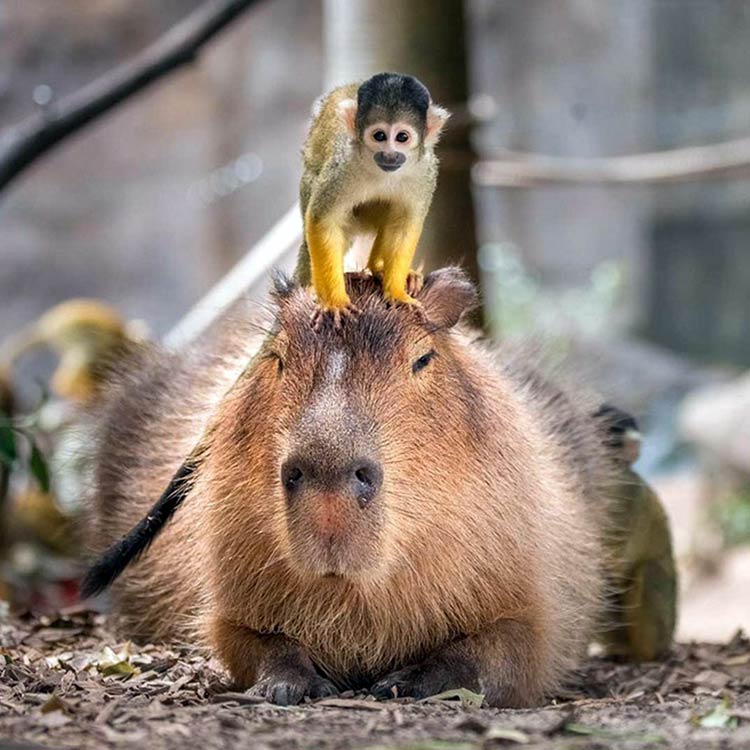
Taxonomy
The capybara (Hydrochoerus hydrochaeris) belongs to the family Caviidae, which includes other species of rodents such as guinea pigs and rock cavies. Within the family, the capybara is the only member of the genus Hydrochoerus.
The scientific name Hydrochoerus hydrochaeris is derived from Greek and means “water pig.” This is a reference to the capybara’s semi-aquatic lifestyle and its physical resemblance to a pig.
There are two recognized subspecies of capybara: Hydrochoerus hydrochaeris hydrochaeris, which is found in much of South America, and Hydrochoerus hydrochaeris isthmius, which is found in Panama and northern Colombia. The two subspecies are similar in appearance, but differ slightly in their physical characteristics and geographical ranges.
The capybara’s taxonomy reflects its unique position as the largest living rodent and a key member of the diverse and fascinating family of Caviidae.
Scientific classification
- Kingdom: Animalia
- Phylum: Chordata
- Class: Mammalia
- Order: Rodentia
- Family: Caviidae
- Genus: Hydrochoerus
- Species: Hydrochoerus hydrochaeris
- Subspecies:
- Hydrochoerus hydrochaeris hydrochaeris
- Hydrochoerus hydrochaeris isthmius

Basic Facts About the Capybara
- The capybara (Hydrochoerus hydrochaeris) is the largest rodent in the world.
- Capybaras are semi-aquatic and can be found near water sources such as rivers, lakes, and swamps in their native South American habitats.
- They have webbed feet and are excellent swimmers, diving underwater to evade predators and to feed on aquatic vegetation.
- Capybaras are herbivores and primarily feed on grasses, aquatic plants, and fruits.
- They are social animals and live in groups of up to 20 individuals in the wild, with a dominant male leading the group.
- Capybaras communicate through vocalizations, scent marking, and body language.
- They have a unique digestive system that allows them to extract nutrients from tough, fibrous plant material, which is why they are known to chew on wood to wear down their constantly growing teeth.
- Capybaras are hunted for their meat and hide by humans in some parts of South America, but they are also considered a nuisance by farmers because they can damage crops.
- Capybaras play an important ecological role as a keystone species, influencing the distribution and abundance of other species through their grazing and feeding habits.
- In some parts of the world, capybaras are kept as pets and have been introduced to other regions as an exotic species. However, their suitability as pets and the ecological impacts of their introduction are subject to debate.
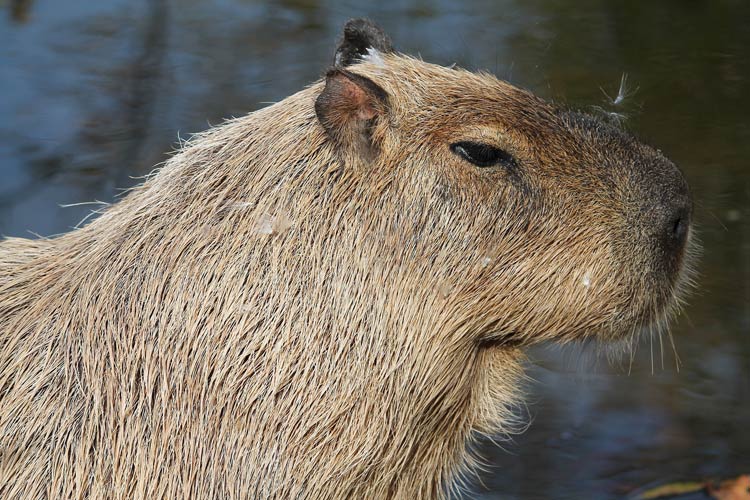
Distribution and habitat
The capybara (Hydrochoerus hydrochaeris) is native to South America, where it can be found in a variety of habitats such as savannas, grasslands, forests, and wetlands. The species has a wide distribution, ranging from Panama in the north to northern Argentina and Uruguay in the south.
Capybaras are semi-aquatic and are often found near water sources such as rivers, lakes, and swamps. They are excellent swimmers, using their webbed feet and streamlined bodies to navigate through waterways. In fact, they are capable of staying submerged for up to five minutes to evade predators or feed on aquatic vegetation.
Capybaras are also adapted to grazing on land and can be found in grasslands and savannas. In these habitats, they feed primarily on grasses and other vegetation. They are known to travel long distances in search of food and water, and are capable of covering up to 10 kilometers (6.2 mi) in a day.
While capybaras are adaptable and can live in a range of habitats, their populations have been affected by habitat loss and hunting by humans. As a result, they are classified as “Least Concern” by the International Union for Conservation of Nature (IUCN), but their populations are declining in some areas. Conservation efforts are underway to protect the species and its habitats in several countries where they occur.
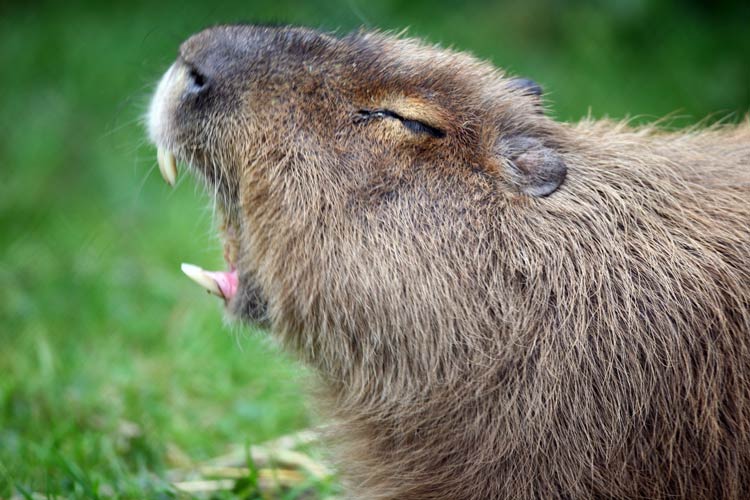
Characteristics
Appearance
The capybara, Hydrochoerus hydrochaeris, is a remarkable creature with distinct physical features. Its dense, coarse fur provides excellent insulation and protection. The coat varies in color, ranging from reddish-brown to a rich, dark brown, allowing capybaras to blend seamlessly with their surroundings. Notably, their heads showcase small, rounded ears and a pair of expressive, dark eyes that exude a gentle curiosity. Additionally, their short legs, equipped with webbed toes, facilitate graceful movements both on land and in the water. The capybara’s appearance is both distinct and captivating, befitting its status as the largest rodent on Earth.
Size
Adult capybaras (Hydrochoerus hydrochaeris) grow to be 106-134 cm (41.7-52.8 inches) in length and stand 50-62 cm (19.7-24.4 inches) tall at the withers. They typically weigh 35-66 kg (77-146 pounds), with an average weight of 48.9 kg (108 pounds) in the Venezuelan llanos. Females are slightly heavier than males. The top recorded weights for wild capybaras are 91 kg (201 pounds) for a female from Brazil and 73.5 kg (162 pounds) for a male from Uruguay. An 81 kg (179 pounds) individual was reported in São Paulo in 2002.

Behavior, Lifestyle and Ecology
- Capybaras are social animals and live in groups of up to 20 individuals in the wild, with a dominant male leading the group.
- They communicate through a variety of vocalizations, scent marking, and body language.
- Capybaras are semi-aquatic and spend a lot of time in or near water sources such as rivers, lakes, and swamps.
- They are excellent swimmers, using their webbed feet and streamlined bodies to navigate through waterways. They can stay submerged for up to five minutes to evade predators or to feed on aquatic vegetation.
- Capybaras are herbivores and primarily feed on grasses, aquatic plants, and fruits.
- They have a unique digestive system that allows them to extract nutrients from tough, fibrous plant material. They are known to chew on wood to wear down their constantly growing teeth.
- Capybaras play an important ecological role as a keystone species, influencing the distribution and abundance of other species through their grazing and feeding habits.
- They are preyed upon by a variety of predators including jaguars, anacondas, and caimans.
- Capybaras are hunted for their meat and hide by humans in some parts of South America, but they are also considered a nuisance by farmers because they can damage crops.
- In some parts of the world, capybaras are kept as pets and have been introduced to other regions as an exotic species. However, their suitability as pets and the ecological impacts of their introduction is subject to debate.

Diet
Capybaras are herbivorous animals and primarily feed on grasses, aquatic plants, and fruits. Their diet can vary depending on their habitat and the availability of food sources. In grasslands and savannas, they feed on a variety of grasses, while in wetlands they feed on aquatic vegetation such as water hyacinths and duckweeds.
Capybaras have a unique digestive system that allows them to extract nutrients from tough, fibrous plant material. They are able to digest cellulose thanks to a specialized chamber in their stomach called the cecum. The cecum is home to bacteria and other microorganisms that help break down tough plant material and extract nutrients. Capybaras are also known to chew on wood to wear down their constantly growing teeth.
While they primarily feed on plant material, capybaras have been observed engaging in coprophagy, or the consumption of their own feces. This behavior is thought to help them extract more nutrients from their food and to help maintain the balance of microorganisms in their digestive system.
Capybaras are also known to travel long distances in search of food and water, and they are capable of covering up to 10 kilometers (6.2 mi) in a day.
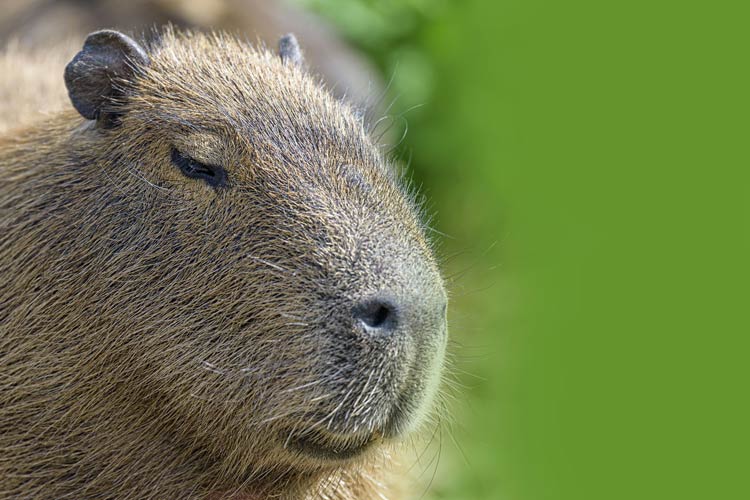
Reproduction and parenting
- Capybaras are polygynous, meaning that a dominant male will mate with multiple females in the group.
- Breeding can occur throughout the year, although in some areas there may be a peak during the rainy season.
- After a gestation period of around 130 to 150 days, females give birth to litters of one to eight young, with the average litter size being four.
- Capybara pups are born fully furred and with open eyes, and they are able to walk within hours of birth.
- Females nurse their young for around 16 weeks, during which time the young are highly dependent on their mother’s milk.
- Capybara young are highly social and form close bonds with their siblings and other members of the group.
- Males do not participate in parental care, but they may protect the young from predators or other threats.
- Capybaras reach sexual maturity at around 1 to 2 years of age, and they can live for up to 8 to 10 years in the wild.
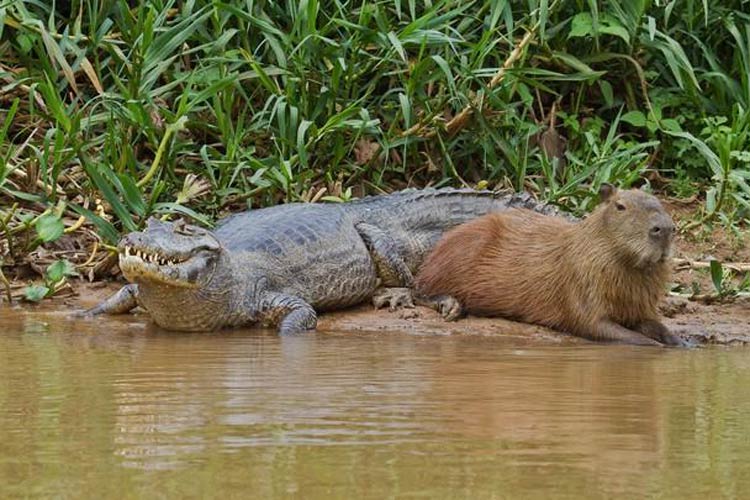
Predators and Threats
- Capybaras are preyed upon by a number of predators, including jaguars, pumas, anacondas, and caimans.
- They have a number of adaptations that help them avoid or defend against predators, including their ability to run quickly and their strong swimming abilities.
- Capybaras are also social animals and often live in groups, which can help protect them from predators by increasing their collective awareness and defense capabilities.
- In addition to predation, capybaras face a number of threats from human activities, including habitat destruction, hunting, and the introduction of non-native species.
- Capybaras are hunted for their meat, hide, and fat, and they are also sometimes targeted as pests in areas where they come into conflict with agriculture or other human activities.
- Habitat loss and fragmentation due to deforestation and other land use changes are major threats to capybara populations, particularly in areas where they are already isolated or endangered.

Interactions with humans
- Capybaras have historically been hunted by humans for their meat, hide, and fat, and they continue to be hunted in some regions today.
- In some areas, capybaras are considered pests and are subject to control measures such as hunting or relocation in order to reduce damage to crops or other human activities.
- Capybaras are also sometimes kept in captivity for display or research purposes.
- Despite these interactions, capybaras are generally not aggressive toward humans and are known for their docile and friendly demeanor.
- In some areas, capybaras have become accustomed to human presence and may even approach humans in search of food or water.
- Capybaras can also be a draw for ecotourism in areas where they are protected or have become habituated to human presence.
- However, it is important for humans to respect the natural behaviors and habitats of capybaras and to avoid disrupting their natural behaviors or causing them harm.

Population
- The exact population size of capybaras is difficult to estimate due to their wide distribution and varying habitats, but they are considered to be a species of “Least Concern” by the International Union for Conservation of Nature (IUCN).
- Capybaras are found throughout much of Central and South America, and their populations are generally considered stable in many areas.
- However, capybaras are threatened by a number of human activities, including habitat destruction and fragmentation, hunting, and persecution as pests or agricultural pests in some regions.
- Some local populations of capybaras have declined or disappeared due to habitat loss or hunting, and in some areas they may be considered endangered or threatened.
- In addition to conservation efforts to protect capybara populations and their habitats, researchers are studying capybaras to better understand their ecology, behavior, and interactions with humans.
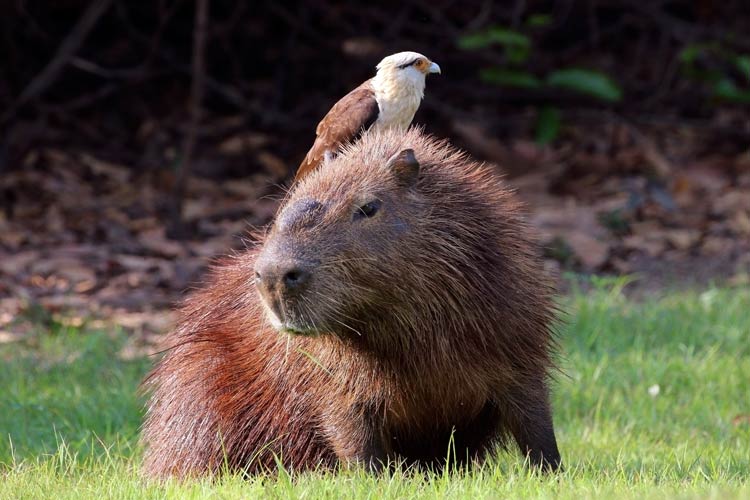
Status and conservation
- Capybaras are classified as a species of “Least Concern” by the International Union for Conservation of Nature (IUCN), which means that they are not currently considered to be at risk of extinction.
- However, capybaras are threatened by a number of human activities, including habitat loss and fragmentation, hunting, and persecution as pests or agricultural pests in some regions.
- Some local populations of capybaras have declined or disappeared due to habitat loss or hunting, and in some areas they may be considered endangered or threatened.
- In some regions, capybaras are protected by law or conservation efforts, such as national parks or protected areas.
- Conservation efforts to protect capybaras and their habitats include measures such as habitat restoration, wildlife corridors, and hunting regulations.
- Researchers are also studying capybaras to better understand their ecology, behavior, and interactions with humans, in order to better inform conservation efforts and improve their long-term survival.
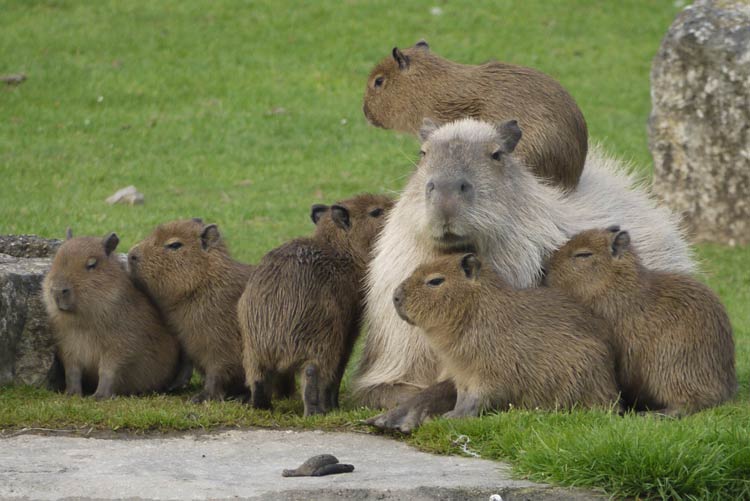
Capybara in numbers / dimensions / size
The capybara, greater capybara (Hydrochoerus hydrochaeris)
- Length: 106 to 134 cm (3.5 to 4.4 ft)
- Height at the withers: 50 to 62 cm (1.6 to 2.0 ft)
- Weight:
- 35 to 66 kg (77 to 146 lb)
- On average 48.9 kg (108 lb)
- The top recorded weights for wild capybaras are:
- Female: 91 kg (201 lb)
- Male: 73.5 kg (162 lb)
- An 81 kg individual was reported in São Paulo in 2002.
- Females are slightly heavier than males
- Lifespan
- 8-10 years in the wild
- 12-14 years in captivity
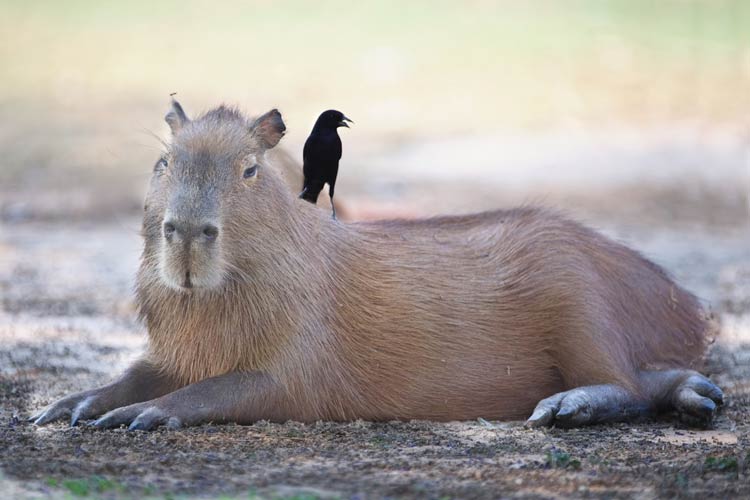
Capybara in culture
- Capybaras have been depicted in art and literature throughout much of their range, and are considered an important cultural and ecological symbol in many areas.
- In some indigenous cultures, capybaras are considered to be a sacred or important animal, and may be associated with creation myths or other important cultural narratives.
- In Brazil, capybaras are sometimes depicted in folklore and popular culture as friendly and playful animals, and are sometimes kept as pets.
- Capybaras have also been the subject of scientific research and popular media, including documentaries and books, which have helped to raise awareness of their ecological importance and conservation needs.
- In recent years, capybaras have also become popular as internet memes and social media personalities, with many people sharing photos and videos of capybaras in cute or humorous situations.
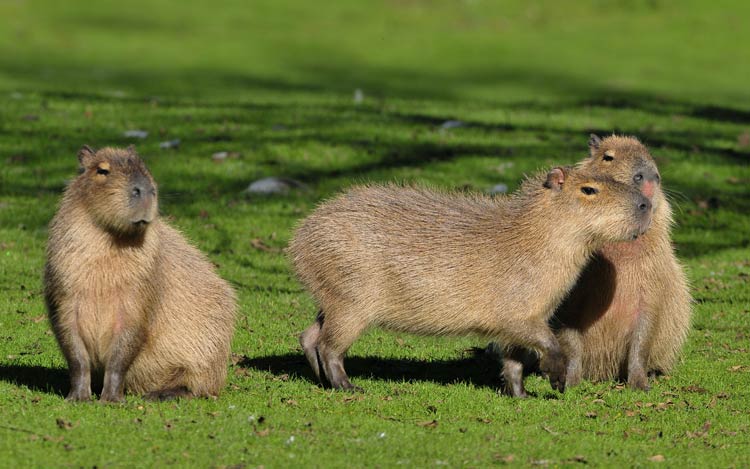
Capybara in movies
While capybaras have appeared in some movies and TV shows, they are not typically the main focus of these productions. Here are a few examples of capybaras appearing in popular media:
- In the 1997 movie “Anaconda” a group of explorers in the Amazon encounter a giant anaconda that feeds on a variety of animals, including capybaras.
- In the 2007 animated film “Surf’s Up,” a group of surfing penguins encounter a variety of animals, including a group of surfing capybaras in one scene.
- In the 2013 movie “Elysium,” capybaras are briefly shown in a futuristic zoo exhibit on a space station.
- Capybaras have also appeared in various wildlife documentaries and nature films, often as part of the diverse array of species found in the wetlands and forests of South America.

Interesting facts about the capybara
- Capybaras are the largest rodents in the world, reaching weights of up to 66 kg (145 lb).
- They are semiaquatic and are excellent swimmers, with webbed feet that help them navigate through water.
- Capybaras are social animals and live in groups of up to 20 individuals, typically consisting of a dominant male, several females, and their offspring.
- Capybaras have a unique digestive system that allows them to extract nutrients from tough, fibrous plants that other animals cannot digest.
- They have a special gland on their noses called the “morillo” gland that they use to mark their territory and communicate with other capybaras.
- Capybaras are hunted for their meat and hides in some regions, and are also sometimes kept as pets in parts of South America.
- In some regions, capybaras are considered pests because they can damage crops or compete with livestock for food and water.
- Despite their large size, capybaras are preyed upon by a variety of predators, including jaguars, anacondas, and caimans.
- Capybaras have a lifespan of up to 8-10 years in the wild, and up to 12-14 years in captivity.
- Capybaras are important ecological indicators of wetland and riparian habitats, and are considered a flagship species for conservation efforts in many parts of their range.
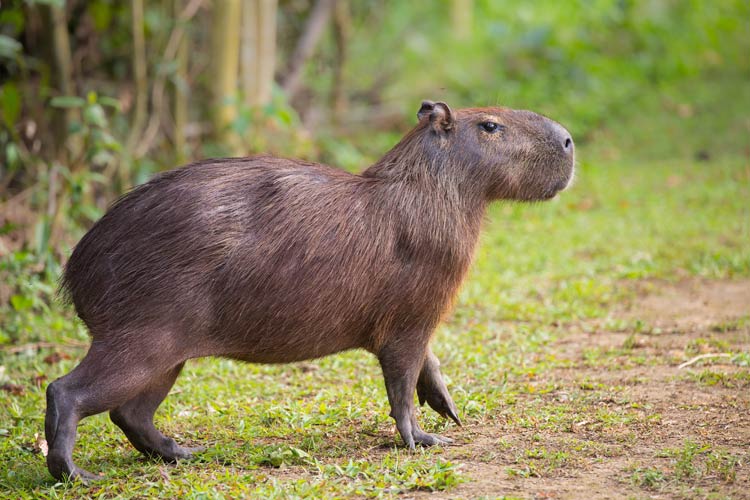
Q&A (questions and answers) about the capybara
Q: What is a capybara?
A: A capybara is a large, semi-aquatic rodent that is native to South America.
Q: How big do capybaras get?
A: Capybaras typically grow to be 106 to 134 cm (42 to 53 inches) long, stand 50 to 62 cm (20 to 24 inches) tall at the withers, and weigh 35 to 66 kg (77 to 145 lbs).
Q: What do capybaras eat?
A: Capybaras are herbivores and mainly eat grasses, aquatic plants, and fruits.
Q: Where do capybaras live?
A: Capybaras are native to South America and are found in a variety of habitats, including wetlands, forests, and savannas.
Q: Are capybaras social animals?
A: Yes, capybaras are highly social animals and live in groups of up to 20 individuals.
Q: What are some predators of capybaras?
A: Some predators of capybaras include jaguars, anacondas, caimans, and eagles.
Q: Do capybaras have any unique adaptations?
A: Yes, capybaras have several unique adaptations, including webbed feet for swimming, a specialized digestive system for extracting nutrients from tough plant material, and a gland on their noses for communicating with other capybaras.
Q: Are capybaras threatened or endangered?
A: Capybaras are listed as a species of least concern by the International Union for Conservation of Nature (IUCN), but they may face local threats due to habitat loss, hunting, and competition with livestock.
